Progress on Protection Strategies to Mitigate the Impact of Renewable Distributed Generation on Distribution Systems
Abstract
:1. Introduction
2. Impact of DG on Distribution Protection System Coordination
3. Protection Strategies for Conventional Distribution System Connected with DG
3.1. Current Practices
3.1.1. Disconnection of DG When Fault Happen
3.1.2. DG Remains Connected When Faults Happen
3.2. Optimal DG Placement and Capacity
3.3. Limiting DG Output Current According to DG Terminal Voltage
4. Protection Strategy for Modified Conventional Distribution System Connected with DGs
4.1. Protection Relays Technology
4.1.1. Directional Overcurrent Relays
4.1.2. Distance Relays
4.1.3. Inverse Time Admittance Relays (ITAs)
4.1.4. Differential Relays
4.2. Adaptive Protection
4.3. Voltage-Based Protection
4.4. Symmetrical Components
4.5. Protection Relay Settings Optimization
4.5.1. Mathematical Algorithm Approach
4.5.2. Meta Heuristic and Intelligent Techniques
4.6. Modification of Fault Current Level
4.6.1. Fault Current Limiters
4.6.2. Energy Storage
4.7. Other Protection Strategies
- DGs’ rotor overheating can be avoided by applying negative sequence protection [117].
- Reverse power protection is used to sense the internal fault from DG and mitigate it either by immediately disconnecting from the DN with a time delay, or riding through the fault [118].
- Auto-reclosure is able to minimize the disconnection impact by auto-reconnecting the DG with the DN depending on a number of faults, especially when due to temporary faults such as surges. However, extra protection needs to be considered to avoid from permanent faults from damaging the equipment [119].
- Among the lightning impacts on DNs connected with DG are the increase of voltage and change of power flow which affect the protection coordination and selectivity, as well as voltage fluctuations. In [120,121], authors proposed lighting protection strategies to determine the optimum size, location and quantification of the surge arresters to protect the DN.
5. Discussion
5.1. Conventional Distribution Protection System
5.2. Modified Distribution Protection System
6. Conclusions and Recommendations
- (a)
- Existing standard and utility codes on distribution protection are the stepping stone towards enjoying the benefits of DG. Enhancement through research will expedite the penetration of DG. Both should enrich the critical requirements by specifying uniform criteria and requirements relevant to the performance, operation, and safety.
- (b)
- Upgrading the protection devices is inevitable in future DNs in order to mitigate the impact of DG while maximizing its benefits.
- (c)
- Irrespective of the protection strategy, adaptive protection via high-speed communication-based solutions will support better operation and protection coordination. This is in line towards the application of self-healing smart grid architectures and IEC61850 in DNs. However, the risk of failure in a communication system has to be mitigated.
- (d)
- Due to the impact of bidirectional power flow on DNs, the need of directional over current relays (DOCRs) is vital.
- (e)
- Publications on optimization of protection relay settings in DG environments are still less numerous compared to other areas in power system protection.
- (f)
- In order to get an optimal protection system and optimal DG benefits, a combined action of different protection strategies will result in better protection and reliability.
- (g)
- For a particular mitigation strategy to be effective, its basic working principles must be comprehensively understood. This will help DNOs select a strategy that best suits their needs and infrastructure.
- (h)
- Looking forward, various available publications have demonstrated different protection strategies to mitigate the impact of DG on DNs, but the solutions are limited. Essentially in perspective of network reconfiguration (NR), further research on NR would be beneficial for researchers, DNOs and industry players.
Acknowledgments
Author Contributions
Conflicts of Interest
References
- Areva, T. Network Protection and Automation Guide; Cayfosa: Barcelona, Spain, 2002; ISBN 2-9518589-0-6. [Google Scholar]
- Conti, S. Analysis of Distribution Network Protection Issues in Presence of Dispersed Generation. Electr. Power Syst. Res. 2009, 79, 49–56. [Google Scholar] [CrossRef]
- Salazar, H.; Gallego, R.; Romero, R. Artificial Neural Networks and Clustering Techniques Applied in the Reconfiguration of Distribution Systems. IEEE Trans. Power Deliv. 2006, 21, 1735–1742. [Google Scholar] [CrossRef]
- Savier, J.; Das, D. Impact of Network Reconfiguration on Loss Allocation of Radial Distribution Systems. IEEE Trans. Power Deliv. 2007, 22, 2473–2480. [Google Scholar] [CrossRef]
- Alex, M.; Josephine, A.A. Impact Due to the Application Location of a Dispersed Generation on the Distribution System Protection with SFCL Application Using Pscad. In Proceedings of the 2013 International Conference on Energy Efficient Technologies for Sustainability (ICEETS), Nagercoil, India, 10–12 April 2013; pp. 1225–1229. [Google Scholar]
- Capitanescu, F.; Ochoa, L.F.; Margossian, H.; Hatziargyriou, N.D. Assessing the Potential of Network Reconfiguration to Improve Distributed Generation Hosting Capacity in Active Distribution Systems. IEEE Trans. Power Syst. 2015, 30, 346–356. [Google Scholar] [CrossRef]
- Rezaei, N.; Haghifam, M.-R. Protection Scheme for a Distribution System with Distributed Generation Using Neural Networks. Int. J. Electr. Power Energy Syst. 2008, 30, 235–241. [Google Scholar] [CrossRef]
- Rao, R.S.; Ravindra, K.; Satish, K.; Narasimham, S. Power Loss Minimization in Distribution System Using Network Reconfiguration in the Presence of Distributed Generation. IEEE Trans. Power Syst. 2013, 28, 317–325. [Google Scholar] [CrossRef]
- Sadeh, J.; Bashir, M.; Kamyab, E. Effect of Distributed Generation Capacity on the Coordination of Protection System of Distribution Network. In Proceedings of the Transmission and Distribution Conference and Exposition: Latin America (T & D-La), Sao Paulo, Brazil, 8–10 November 2010; pp. 110–115. [Google Scholar]
- Bo, Z.; Wang, Q.; Zhao, Y.; Wang, L.; Chen, L.; Wei, F. A New Concept Intelligent Integrated Protection System for Distribution Network. In Proceedings of the 5th International Conference on Electric Utility Deregulation and Restructuring and Power Technologies (DRPT), Changsha, China, 26–29 November 2015; pp. 894–898. [Google Scholar]
- Chakor, S.V.; Date, T.N. Optimum Coordination of Directional Overcurrent Relays Using Genetic Algorithm Optimization Technique. In Proceedings of the 10th International Conference on Intelligent Systems and Control (ISCO), Coimbatore, India, 7–8 January 2016; pp. 1–6. [Google Scholar]
- Kida, A.A.; Gallego, L.A. A High-Performance Hybrid Algorithm to Solve the Optimal Coordination of Overcurrent Relays in Radial Distribution Networks Considering Several Curve Shapes. Electr. Power Syst. Res. 2016, 140, 464–472. [Google Scholar] [CrossRef]
- Sheng, W.; Meng, X.; Ma, J. A New Adaptive Current Protection Scheme for Distributed Systems with Distributed Generation. In Proceedings of the International Power, Electronics and Materials Engineering Conference (IPEMEC 2015), Dalian, China, 16–17 May 2015. [Google Scholar]
- Khederzadeh, M.; Javadi, H.; Mousavi, S.A. Source Type Impact of Distributed Generation (Dg) on the Distribution Protection. In Proceedings of the 10th IET International Conference on Developments in Power System Protection (DPSP 2010), Manchester, UK, 29 March–1 April 2010. [Google Scholar]
- Elsaiah, S.; Benidris, M.; Mitra, J. Analytical Approach for Placement and Sizing of Distributed Generation on Distribution Systems. IET Gener. Transm. Distrib. 2014, 8, 1039–1049. [Google Scholar] [CrossRef]
- Koumba, P.M.; Chériti, A.; Doumbia, M.L. Impacts of Distributed Generation on the Coordination of Protective Devices in Distribution Network. In Proceedings of the IEEE 28th Canadian Conference on Electrical and Computer Engineering (CCECE), Halifax, NS, Canada, 3–6 May 2015; pp. 460–465. [Google Scholar]
- Naiem, A.; Hegazy, Y.; Abdelaziz, A.; Elsharkawy, M. A Classification Technique for Recloser-Fuse Coordination in Distribution Systems with Distributed Generation. IEEE Trans. Power Deliv. 2012, 27, 176–185. [Google Scholar] [CrossRef]
- Brahma, S.M.; Girgis, A.A. Microprocessor-Based Reclosing to Coordinate Fuse and Recloser in a System with High Penetration of Distributed Generation. In Proceedings of the Power Engineering Society Winter Meeting, New York, NY, USA, 27–31 January 2002; pp. 453–458. [Google Scholar]
- Balamurugan, K.; Srinivasan, D.; Reindl, T. Impact of Distributed Generation on Power Distribution Systems. Energy Procedia 2012, 25, 93–100. [Google Scholar] [CrossRef]
- Favuzza, S.; Ippolito, M.; Massaro, F. Investigating the Effect of Distributed Generators on Traditional Protection in Radial Distribution Systems. In Proceedings of the Powertech Grenoble (Powertech), Grenoble, France, 16–20 June 2013; pp. 1–6. [Google Scholar]
- Dai, F. Impacts of Distributed Generation on Protection and Autoreclosing of Distribution Networks. In Proceedings of the 10th IET International Conference on Developments in Power System Protection (DPSP 2010), Manchester, UK, 29 March–1 April 2010. [Google Scholar]
- Matcha, M.; Papani, S.K.; Killamsetti, V. Adaptive Relaying of Radial Distribution System with Distributed Generation. Int. J. Electr. Comput. Eng. 2013, 3, 407. [Google Scholar] [CrossRef]
- Wang, W.; Pan, Z.C.; Cong, W.; Yu, C.G.; Gu, F. Impact of Distributed Generation on Relay Protection and Its Improved Measures. In Proceedings of the 2008 China International Conference on Electricity Distribution (CICED 2008), Guangzhou, China, 10–13 December 2008; Volume 1–2, p. 61. [Google Scholar]
- Ma, J.; Wang, X.; Zhang, Y.; Yang, Q.; Phadke, A. A Novel Adaptive Current Protection Scheme for Distribution Systems with Distributed Generation. Int. J. Electr. Power Energy Syst. 2012, 43, 1460–1466. [Google Scholar] [CrossRef]
- Javadian, S.; Haghifam, M.-R.; Bathaee, S.; Firoozabad, M.F. Adaptive Centralized Protection Scheme for Distribution Systems with Dg Using Risk Analysis for Protective Devices Placement. Int. J. Electr. Power Energy Syst. 2013, 44, 337–345. [Google Scholar] [CrossRef]
- Zayandehroodi, H.; Mohamed, A.; Shareef, H.; Farhoodnea, M. A Novel Neural Network and Backtracking Based Protection Coordination Scheme for Distribution System with Distributed Generation. Int. J. Electr. Power Energy Syst. 2012, 43, 868–879. [Google Scholar] [CrossRef]
- IEEE Standard for Interconnecting Distributed Resources with Electric Power Systems; IEEE Std 1547–2003; Institute of Electrical and Electronics Engineers: New York, NY, USA, 2003; pp. 1–28. [CrossRef]
- Basso, T.; Hambrick, J.; Deblasio, D. Update and Review of IEEE P2030 Smart Grid Interoperability and IEEE 1547 Interconnection Standards. In Proceedings of the Innovative Smart Grid Technologies (ISGT), Washington, DC, USA, 16–20 January 2012; pp. 1–7. [Google Scholar]
- Roy, N.; Pota, H. Current Status and Issues of Concern for the Integration of Distributed Generation into Electricity Networks. IEEE Syst. J. 2015, 9, 933–944. [Google Scholar] [CrossRef]
- Standard for Grid Connection of Energy Inverter Systems via Inverter. In Part 3: Grid Protection Requirements; AS 4777.3–2005; Standards Australia: Sydney, Australia, 2005.
- Teodorescu, R.; Liserre, M.; Rodriguez, P. Grid Converters for Photovoltaic and Wind Power Systems; John Wiley & Sons: Hoboken, NJ, USA, 2011; Volume 29. [Google Scholar]
- Crăciun, B.-I.; Kerekes, T.; Séra, D.; Teodorescu, R. Overview of Recent Grid Codes for PV Power Integration. In Proceedings of the 13th International Conference on Optimization of Electrical and Electronic Equipment (Optim), Brasov, Romania, 24–26 May 2012; pp. 959–965. [Google Scholar]
- Preda, T.-N.; Uhlen, K.; Nordgård, D.E. An Overview of the Present Grid Codes for Integration of Distributed Generation. In Proceedings of the CIRED 2012 Workshop: Integration of Renewables into the Distribution Grid, Lisbon, Portugal, 29–30 May 2012. [Google Scholar]
- Antonova, G.; Nardi, M.; Scott, A.; Pesin, M. Distributed Generation and Its Impact on Power Grids and Microgrids Protection. In Proceedings of the 65th Annual Conference for Protective Relay Engineers, College Station, TX, USA, 2–5 April 2012; pp. 152–161. [Google Scholar]
- Hossain, J.; Pota, H.R. Control for Fault Ride-Through Capability Augmentation. In Robust Control for Grid Voltage Stability: High Penetration of Renewable Energy; Springer: Berlin, Germany, 2014; pp. 153–218. [Google Scholar]
- Oudalov, A.; Fidigatti, A.; Degner, T.; Valov, B.; Hardt, C.; Yarza, J.A. Novel Protection Systems for Microgrids. Advanced Architecture and Control Concepts for More Microgrids. Available online: http://www.microgrids.eu/documents/688.pdf (accessed on 12 November 2017).
- Hernández, J.; De La Cruz, J.; Ogayar, B. Electrical Protection for the Grid-Interconnection of Photovoltaic-Distributed Generation. Electr. Power Syst. Res. 2012, 89, 85–99. [Google Scholar] [CrossRef]
- Rahmann, C.; Haubrich, H.-J.; Moser, A.; Palma-Behnke, R.; Vargas, L.; Salles, M.B.D.C. Justified Fault-Ride-Through Requirements for Wind Turbines in Power Systems. IEEE Trans. Power Syst. 2011, 26, 1555–1563. [Google Scholar] [CrossRef]
- El Moursi, M.S.; Xiao, W.; Kirtley, J.L., Jr. Fault Ride Through Capability for Grid Interfacing Large Scale PV Power Plants. IET Gener. Transm. Distrib. 2013, 7, 1027–1036. [Google Scholar] [CrossRef]
- Yazdanpanahi, H.; Li, Y.W.; Xu, W. A New Control Strategy to Mitigate the Impact of Inverter-Based Dgs on Protection System. IEEE Trans. Smart Grid 2012, 3, 1427–1436. [Google Scholar] [CrossRef]
- Buigues, G.; Dyśko, A.; Valverde, V.; Zamora, I.; Fernández, E. Microgrid Protection: Technical Challenges and Existing Techniques. Renew. Energy Power Qual. J. 2013, 6, 1280–1292. [Google Scholar] [CrossRef]
- Solar Energy Plants Grid Connection Code—In Addition to the Egyptian Transmission Grid Code and the Egyptian Distribution Network; Egyptian Distribution Network; EgyptERA Committee: Cairo, Egypt, 2017.
- Malaysia, E.C.O. Guidelines on Large Scale Solar Photovoltaic Plant for Connection to Electricity Networks. In Gp/St/No.1/2016, April 2016 ed.; Malaysia, E.C.O., Ed.; Energy Commission: Putrajaya, Malaysia, 2016; p. 685. [Google Scholar]
- Harrison, G.; Wallace, A. Optimal Power Flow Evaluation of Distribution Network Capacity for the Connection of Distributed Generation. IEE Proc. Gener. Transm. Distrib. 2005, 152, 115–122. [Google Scholar] [CrossRef]
- Zhan, H.; Wang, C.; Wang, Y.; Yang, X.; Zhang, X.; Wu, C.; Chen, Y. Relay Protection Coordination Integrated Optimal Placement and Sizing of Distributed Generation Sources in Distribution Networks. IEEE Trans. Smart Grid 2016, 7, 55–65. [Google Scholar] [CrossRef]
- Saksornchai, T.; Eua-Arporn, B.; Praserthdam, P.; Editor, E.; Intakan, E.; Office, E.; Zhao, Y. Determination of Allowable Capacity of Distributed Generation with Protection Coordination Consideration. Eng. J. 2009, 13. [Google Scholar] [CrossRef]
- Mirsaeidi, S.; Shirazi, M.G.; Ghaffari, K.; Mirsaeidi, M. Determination of Allowable Capacity of Distributed Generation Units for the Prevention of Protection Mis-Coordination in Distribution Networks. J. Appl. Environ. Biol. Sci. (JAEBS) 2013, 3, 116–124. [Google Scholar]
- Elsaiah, S.; Benidris, M.; Mitra, J. A Method for Reliability Improvement of Microgrids. In Proceedings of the Power Systems Computation Conference (PSCC), Genoa, Italy, 20–24 June 2016; pp. 1–7. [Google Scholar]
- Badran, O.; Mekhilef, S.; Mokhlis, H.; Dahalan, W. Optimal Reconfiguration of Distribution System Connected with Distributed Generations: A Review of Different Methodologies. Renew. Sustain. Energy Rev. 2017, 73, 854–867. [Google Scholar] [CrossRef]
- Kennedy, J.; Ciufo, P.; Agalgaonkar, A. A Review of Protection Systems for Distribution Networks Embedded with Renewable Generation. Renew. Sustain. Energy Rev. 2016, 58, 1308–1317. [Google Scholar] [CrossRef]
- Bakar, A.H.A.; Ooi, B.; Govindasamy, P.; Tan, C.; Illias, H.A.; Mokhlis, H. Directional Overcurrent and Earth-Fault Protections for A Biomass Microgrid System in Malaysia. Int. J. Electr. Power Energy Syst. 2014, 55, 581–591. [Google Scholar] [CrossRef]
- Jones, D.; Kumm, J.J. Future Distribution Feeder Protection Using Directional Overcurrent Elements. IEEE Trans. Ind. Appl. 2014, 50, 1385–1390. [Google Scholar] [CrossRef]
- Zeineldin, H.H.; Sharaf, H.M.; Ibrahim, D.K.; El-Zahab, E.E.-D.A. Optimal Protection Coordination for Meshed Distribution Systems with Dg Using Dual Setting Directional Over-Current Relays. IEEE Trans. Smart Grid 2015, 6, 115–123. [Google Scholar] [CrossRef]
- Huchel, Ł.; Zeineldin, H.H. Planning the Coordination of Directional Overcurrent Relays for Distribution Systems Considering DG. IEEE Trans. Smart Grid 2016, 7, 1642–1649. [Google Scholar] [CrossRef]
- Bhalja, B.; Shah, P.; Chothani, N.; Patel, R. A Novel Approach to Tackle Miscoordination of Protective Device in Radial Distribution Network During Dg Interconnections. Int. J. Emerg. Electr. Power Syst. 2011, 12, 1–21. [Google Scholar] [CrossRef]
- Kundur, P.S. Power System Stability. In Power System Stability and Control, 3rd ed.; CRC Press: Boca Raton, FL, USA, 2012; pp. 1–12. [Google Scholar]
- Sadeghi, H. A Novel Method for Adaptive Distance Protection of Transmission Line Connected to Wind Farms. Int. J. Electr. Power Energy Syst. 2012, 43, 1376–1382. [Google Scholar] [CrossRef]
- Chilvers, I.; Jenkins, N.; Crossley, P. Distance Relaying of 11 kv Circuits to Increase the Installed Capacity of Distributed Generation. IEE Proc. Gener. Transm. Distrib. 2005, 152, 40–46. [Google Scholar] [CrossRef]
- Uthitsunthorn, D.; Kulworawanichpong, T. Distance Protection of a Renewable Energy Plant in Electric Power Distribution Systems. In Proceedings of the 2010 International Conference on Power System Technology, Hangzhou, China, 24–28 October 2010; pp. 1–6. [Google Scholar]
- Requirements for the Interconnection of Distributed Generation to the Hydro-Québec Medium-Voltage Distribution System (Between 750 V to 44000 V); Hydro-Québec Std., Technical System Orientations Group: Toronto, ON, Canada, 2004.
- Distributed Generation Technical Interconnection Requirements—Interconnections at Voltages 50 kv and Below; Hydro One Network Inc. Research Team: Toronto, ON, Canada, 2013.
- Mortazavi, H.; Mehrjerdi, H.; Saad, M.; Lefebvre, S.; Asber, D.; Lenoir, L. Application of Distance Relay for Distribution System Monitoring. In Proceedings of the Power & Energy Society General Meeting, Denver, CO, USA, 26–30 July 2015; pp. 1–5. [Google Scholar]
- Dewadasa, M.; Ghosh, A.; Ledwich, G. An Inverse Time Admittance Relay for Fault Detection in Distribution Networks Containing Dgs. In Proceedings of the Tencon 2009–2009 IEEE Region 10 Conference, Singapore, 23–26 January 2009; pp. 1–6. [Google Scholar]
- Dewadasa, M.; Ghosh, A.; Ledwich, G. Fold Back Current Control and Admittance Protection Scheme for a Distribution Network Containing Distributed Generators. IET Gener. Transm. Distrib. 2010, 4, 952–962. [Google Scholar] [CrossRef]
- Mirsaeidi, S.; Said, D.M.; Mustafa, M.W.; Habibuddin, M.H.; Ghaffari, K. An Analytical Literature Review of the Available Techniques for the Protection of Micro-Grids. Int. J. Electr. Power Energy Syst. 2014, 58, 300–306. [Google Scholar] [CrossRef]
- Majumder, R.; Dewadasa, M.; Ghosh, A.; Ledwich, G.; Zare, F. Control and Protection of a Microgrid Connected to Utility Through Back-To-Back Converters. Electr. Power Syst. Res. 2011, 81, 1424–1435. [Google Scholar] [CrossRef] [Green Version]
- Thamilvalluvan, B.; Aswini, P.; Antobennet, M.; Dhiviya, K.; Revathi, R.; Steffi, T. A Novel Relay Used for Fault Detection and Isolation in Distribution Networks Containing of Several Dgs. In Proceedings of the International Conference on Electrical, Electronics, and Optimization Techniques (ICEEOT), Chennai, India, 3–5 March 2016; pp. 3574–3580. [Google Scholar]
- Dewadasa, M.; Ghosh, A.; Ledwich, G. Protection of Microgrids Using Differential Relays. In Proceedings of the Power Engineering Conference (AUPEC), Australasian Universities, Brisbane, Australia, 25–28 September 2011; pp. 1–6. [Google Scholar]
- Ustun, T.S.; Ozansoy, C.; Zayegh, A. Differential Protection of Microgrids with Central Protection Unit Support. In Proceedings of the IEEE 2013 Tencon—Spring, Sydney, Australia, 17–19 April 2013; pp. 15–19. [Google Scholar]
- Almutairy, I. A Review of Coordination Strategies and Techniques for Overcoming Challenges to Microgrid Protection. In Proceedings of the Smart Grid (Sasg), Jeddah, Saudi Arabia, 6–8 December 2016; pp. 1–4. [Google Scholar]
- Gers, J.; Viggiano, C. Protective Relay Setting Criteria Considering Ders and Distributed Automation. In Proceedings of the 13th International Conference on Development in Power System Protection 2016 (DPSP), Edinburgh, UK, 7–10 March 2016. [Google Scholar]
- Shah, P.H.; Bhalja, B.R. New Adaptive Digital Relaying Scheme to Tackle Recloser-Fuse Miscoordination During Distributed Generation Interconnections. IET Gener. Transm. Distrib. 2014, 8, 682–688. [Google Scholar] [CrossRef]
- Khederzadeh, M. Adaptive Setting of Protective Relays in Microgrids in Grid-Connected and Autonomous Operation. In Proceedings of the 11th International Conference on Developments in Power Systems Protection, Birmingham, UK, 23–26 April 2012. [Google Scholar]
- Laaksonen, H.J. Protection Principles for Future Microgrids. IEEE Trans. Power Electron. 2010, 25, 2910–2918. [Google Scholar] [CrossRef]
- Conti, S.; Raffa, L.; Vagliasindi, U. Innovative Solutions for Protection Schemes in Autonomous MV Micro-Grids. In Proceedings of the 2009 International Conference on Clean Electrical Power, Capri, Italy, 9–11 June 2009; pp. 647–654. [Google Scholar]
- Favuzza, S.; Ippolito, M.; Massaro, F. An Investigation of Protection Devices Coordination Effects on Distributed Generators Capacity in Radial Distribution Systems. In Proceedings of the 2013 International Conference on Clean Electrical Power (ICCEP), Alghero, Italy, 11–13 June 2013; pp. 686–692. [Google Scholar]
- Wang, L.; Zhou, L.; Cheung, H.; Hamlyn, A.; Mander, T.; Lee, I.; Cheung, R. Adaptive Protection and Control Strategy for Interfacing Wind Generators to Distribution Grids. In Proceedings of the International Conference on Electrical Machines and Systems, Wuhan, China, 17–20 October 2008; pp. 2478–2483. [Google Scholar]
- Best, R.J.; Morrow, D.J.; Crossley, P.A. Communication Assisted Protection Selectivity for Reconfigurable and Islanded Power Networks. In Proceedings of the 44th International Universities Power Engineering Conference (UPEC), Glasgow, UK, 1–4 September 2009; pp. 1–5. [Google Scholar]
- Brahma, S.M.; Girgis, A.A. Development of Adaptive Protection Scheme for Distribution Systems with High Penetration of Distributed Generation. IEEE Trans. Power Deliv. 2004, 19, 56–63. [Google Scholar] [CrossRef]
- Ma, J.; Mi, C.; Wang, T.; Wu, J.; Wang, Z. An Adaptive Protection Scheme for Distributed Systems with Distributed Generation. In Proceedings of the Power and Energy Society General Meeting, Detroit, MI, USA, 24–29 July 2011; pp. 1–6. [Google Scholar]
- Ozansoy, C. Design of an Adaptive Protection System for Microgrids with Distributed Energy Resources in Accordance with IEC 61850–7-420. In Proceedings of the 9th International Conference on Electrical and Electronics Engineering (ELECO), Bursa, Turkey, 26–28 November 2015; pp. 474–478. [Google Scholar]
- Ustun, T.S. Interoperability and Interchangeability for Microgrid Protection Systems Using IEC 61850 Standard. In Proceedings of the IEEE International Conference on Power and Energy (PECON), Melaka, Malaysia, 28–29 November 2016; pp. 7–12. [Google Scholar]
- Khan, R.H.; Brown, J.; Khan, J.Y. Pilot Protection Schemes over a Multi-Service Wimax Network in the Smart Grid. In Proceedings of the 2013 IEEE International Conference on Communications Workshops (ICC), Budapest, Hungary, 9–13 June 2013; pp. 994–999. [Google Scholar]
- Al-Nasseri, H.; Redfern, M.; O’gorman, R. Protecting Micro-Grid Systems Containing Solid-State Converter Generation. In Proceedings of the International Conference on Future Power Systems, Amsterdam, The Netherlands, 18 November 2005; p. 5. [Google Scholar]
- Al-Nasseri, H.; Redfern, M.; Li, F. A Voltage Based Protection for Micro-Grids Containing Power Electronic Converters. In Proceedings of the Power Engineering Society General Meeting, Montreal, QC, Canada, 18–22 June 2006; p. 7. [Google Scholar]
- Hou, C.; Hu, X. A Study of Voltage Detection Based Fault Judgement Method in Micro-Grid with Inverter Interfaced Power Source. In Proceedings of the International Conference on Electrical Engineering, Shenyang, China, 5–9 July 2009; pp. 1–5. [Google Scholar]
- Loix, T.; Wijnhoven, T.; Deconinck, G. Protection of Microgrids with a High Penetration of Inverter-Coupled Energy Sources. In Proceedings of the Integration of Wide-Scale Renewable Resources into the Power Delivery System, 2009 Cigre/IEEE Pes Joint Symposium, Calgary, AB, Canada, 29–31 July 2009; pp. 1–6. [Google Scholar]
- Wang, X.-P.; Li, Y.; Yu, Y.-Y. Research on the Relay Protection System for a Small Laboratory-Scale Microgrid System. In Proceedings of the 6th IEEE Conference on Industrial Electronics and Applications (ICIEA), Beijing, China, 21–23 June 2011; pp. 2712–2716. [Google Scholar]
- Nikkhajoei, H.; Lasseter, R.H. Microgrid Fault Protection Based on Symmetrical and Differential Current Components. Power Syst. Eng. Res. Center 2006, 1, 71–74. [Google Scholar]
- Xu, M.; Zou, G.; Xu, C.; Sun, W.; Mu, S. Positive Sequence Differential Impedance Protection for Distribution Network with Ibdgs. In Proceedings of the IEEE International Conference on Power System Technology (Powercon), Wollongong, Australia, 28 September–1 October 2016; pp. 1–5. [Google Scholar]
- Zhang, Z.; Crossley, P.; Xu, B.; Yin, M. Sequence Current Component and Its Power Direction-Based Improved Protection for Spot Network with Ders. IET Gener. Transm. Distrib. 2017, 11, 1634–1644. [Google Scholar] [CrossRef]
- Zhang, Z.-H.; Xu, B.-Y.; Crossley, P.; Li, L. Positive-Sequence-Fault-Component-Based Blocking Pilot Protection for Closed-Loop Distribution Network with Underground Cable. Int. J. Electr. Power Energy Syst. 2018, 94, 57–66. [Google Scholar] [CrossRef]
- Ehrenberger, J.; Švec, J. Protection Settings Optimization in Distributed Generation System. In Proceedings of the IEEE International Energy Conference (Energycon), Leuven, Belgium, 5–7 April 2016; pp. 1–6. [Google Scholar]
- Bouchekara, H.; Zellagui, M.; Abido, M.A. Optimal Coordination of Directional Overcurrent Relays Using a Modified Electromagnetic Field Optimization Algorithm. Appl. Soft Comput. 2017, 54, 267–283. [Google Scholar] [CrossRef]
- Sharaf, H.M.; Zeineldin, H.; Ibrahim, D.K.; Essam, E. A Proposed Coordination Strategy for Meshed Distribution Systems with DG Considering User-Defined Characteristics of Directional Inverse Time Overcurrent Relays. Int. J. Electr. Power Energy Syst. 2015, 65, 49–58. [Google Scholar] [CrossRef]
- Najy, W.K.A.; Zeineldin, H.H.; Woon, W.L. Optimal Protection Coordination for Microgrids with Grid-Connected and Islanded Capability. IEEE Trans. Ind. Electron. 2013, 60, 1668–1677. [Google Scholar] [CrossRef]
- Chakor, S.V.; Date, T.N. Optimum Coordination of Directional Overcurrent Relay in Presence of Distributed Generation Using Genetic Algorithm. In Proceedings of the 2016 10th International Conference on Intelligent Systems and Control (ISCO), Coimbatore, India, 7–8 January 2016; pp. 1–5. [Google Scholar]
- Chakor, V.R.A. A Review on Impact of Distributed Generation on Directional Overcurrent Relay Coordination. IOSR J. Electr. Electron. Eng. (IOSR-JEEE) 2017, E-Issn: 2278–1676, P-Issn: 2320–3331, 44–49. [Google Scholar]
- Zeineldin, H.H.; El-Saadany, E.F.; Salama, M.M.A. Optimal Coordination of Overcurrent Relays Using a Modified Particle Swarm Optimization. Electr. Power Syst. Res. 2006, 76, 988–995. [Google Scholar] [CrossRef]
- Qu, H.; Jia, Q.; Bo, Z. Mpso Based Protective Relay Coordination for Micro-Grid. In Proceedings of the 10th IET International Conference on Developments in Power System Protection (DPSP 2010), Manchester, UK, 29 March–1 April 2010; pp. 1–5. [Google Scholar]
- Papaspiliotopoulos, V.A.; Kurashvili, T.; Korres, G.N. Optimal Coordination of Directional Overcurrent Relays in Distribution Systems with Distributed Generation Based on a Hybrid Pso-Lp Algorithm. In Proceedings of the MedPower 2014, Athens, Greece, 2–5 November 2014. [Google Scholar]
- Tuitemwong, K.; Premrudeepreechacharn, S. Expert System for Protection Coordination of Distribution System with Distributed Generators. Int. J. Electr. Power Energy Syst. 2011, 33, 466–471. [Google Scholar] [CrossRef]
- Ustun, T.S.; Ozansoy, C.; Zayegh, A. A Central Microgrid Protection System for Networks with Fault Current Limiters. In Proceedings of the 10th International Conference on Environment and Electrical Engineering (EEEIC), Rome, Italy, 8–11 May 2011; pp. 1–4. [Google Scholar]
- Kalage, A.A.; Ghawghawe, N.D.; Deokar, T.V. Optimum Location of Superconducting Fault Current Limiter to Mitigate Dg Impact. In Proceedings of the 2nd International Conference on Advances in Electrical, Electronics, Information, Communication and Bio-Informatics (AEEICB), Chennai, India, 27–28 February 2016; pp. 704–707. [Google Scholar]
- Elmitwally, A.; Gouda, E.; Eladawy, S. Optimal Allocation of Fault Current Limiters for Sustaining Overcurrent Relays Coordination in a Power System with Distributed Generation. Alex. Eng. J. 2015, 54, 1077–1089. [Google Scholar] [CrossRef]
- El-Khattam, W.; Sidhu, T.S. Restoration of Directional Overcurrent Relay Coordination in Distributed Generation Systems Utilizing Fault Current Limiter. IEEE Trans. Power Deliv. 2008, 23, 576–585. [Google Scholar] [CrossRef]
- Lee, B.; Sim, J.; Park, K.; Oh, I. Practical Application Issues of Superconducting Fault Current Limiters for Electric Power Systems. IEEE Trans. Appl. Supercond. 2008, 18, 620–623. [Google Scholar] [CrossRef]
- Li, Q.; Liu, H.; Lou, J.; Zou, L. Impact Research of Inductive FCL on the Rate of Rise of Recovery Voltage with Circuit Breakers. IEEE Trans. Power Deliv. 2008, 23, 1978–1985. [Google Scholar]
- Chen, L.; Deng, C.; Guo, F.; Tang, Y.; Shi, J.; Ren, L. Reducing the Fault Current and Overvoltage in a Distribution System with Distributed Generation Units Through an Active Type SFCL. IEEE Trans. Appl. Supercond. 2014, 24, 1–5. [Google Scholar]
- Jayawarna, N.; Barnes, M. Central Storage Unit Response Requirement in ‘Good Citizen’microgrid. In Proceedings of the 13th European Conference on Power Electronics and Applications, Barcelona, Spain, 8–10 September 2009; pp. 1–10. [Google Scholar]
- Chen, L.; Chen, H.; Yang, J.; Yu, Y.; Zhen, K.; Liu, Y.; Ren, L. Coordinated Control of Superconducting Fault Current Limiter and Superconducting Magnetic Energy Storage for Transient Performance Enhancement of Grid-Connected Photovoltaic Generation System. Energies 2017, 10, 56. [Google Scholar] [CrossRef]
- Guo, W.; Xiao, L.; Dai, S. Enhancing Low-Voltage Ride-Through Capability and Smoothing Output Power of DFIG with a Superconducting Fault-Current Limiter–Magnetic Energy Storage System. IEEE Trans. Energy Convers. 2012, 27, 277–295. [Google Scholar] [CrossRef]
- Duggirala, V.A.; Gundavarapu, V.N.K. Improved LVRT for Grid Connected DFIG Using Enhanced Field Oriented Control Technique with Super Capacitor as External Energy Storage System. Eng. Sci. Technol. Int. J. 2016, 19, 1742–1752. [Google Scholar] [CrossRef]
- Ngamroo, I.; Vachirasricirikul, S. Coordinated Control of Optimized SFCL and Smes for Improvement of Power System Transient Stability. IEEE Trans. Appl. Supercond. 2012, 22, 5600805. [Google Scholar] [CrossRef]
- Ngamroo, I.; Karaipoom, T. Cooperative Control of SFCL and SMES for Enhancing Fault Ride through Capability and Smoothing Power Fluctuation of DFIG Wind Farm. IEEE Trans. Appl. Supercond. 2014, 24, 1–4. [Google Scholar] [CrossRef]
- Jouybari-Moghaddam, H.; Hosseinian, S.; Vahidi, B. An Introduction to Active Distribution Networks Islanding Issues. In Proceedings of the 17th Conference on Electrical Power Distribution Networks (EPDC), Tehran, Iran, 2–3 May 2012; pp. 1–6. [Google Scholar]
- Torres, R.; Hagphanah, A.; Bower, T.; Delay, R.; Paes, R. Adjustable Speed Drives and Motor Protection. In Proceedings of the Petroleum and Chemical Industry Technical Conference (PCIC), San Francisco, CA, USA, 8–10 September 2014; pp. 119–128. [Google Scholar]
- Boemer, J.C.; Rawn, B.G.; Gibescu, M.; Van Der Meijden, M.A.; Kling, W.L. Response of Wind Power Park Modules in Distribution Systems to Transmission Network Faults During Reverse Power Flows. IET Renew. Power Gener. 2015, 9, 1033–1042. [Google Scholar] [CrossRef]
- Wheeler, K.A.; Elsamahy, M.; Faried, S.O. A Novel Reclosing Scheme for Mitigation of Distributed Generation Effects on Overcurrent Protection. IEEE Trans. Power Deliv. 2017. [Google Scholar] [CrossRef]
- Vita, V.; Ekonomou, L.; Christodoulou, C.A. The Impact of Distributed Generation to the Lightning Protection of Modern Distribution Lines. Energy Syst. 2016, 7, 357–364. [Google Scholar] [CrossRef]
- Araujo, M.; Flauzino, R.; Batista, O.; Moraes, L.; Martins, C. Protection of the Distribution Lines with Distributed Generation Against Lightning Overvoltages in the Context of Smart Grids. In Proceedings of the 2013 World Congress on Sustainable Technologies (WCST), London, UK, 9–12 December 2013; pp. 36–41. [Google Scholar]
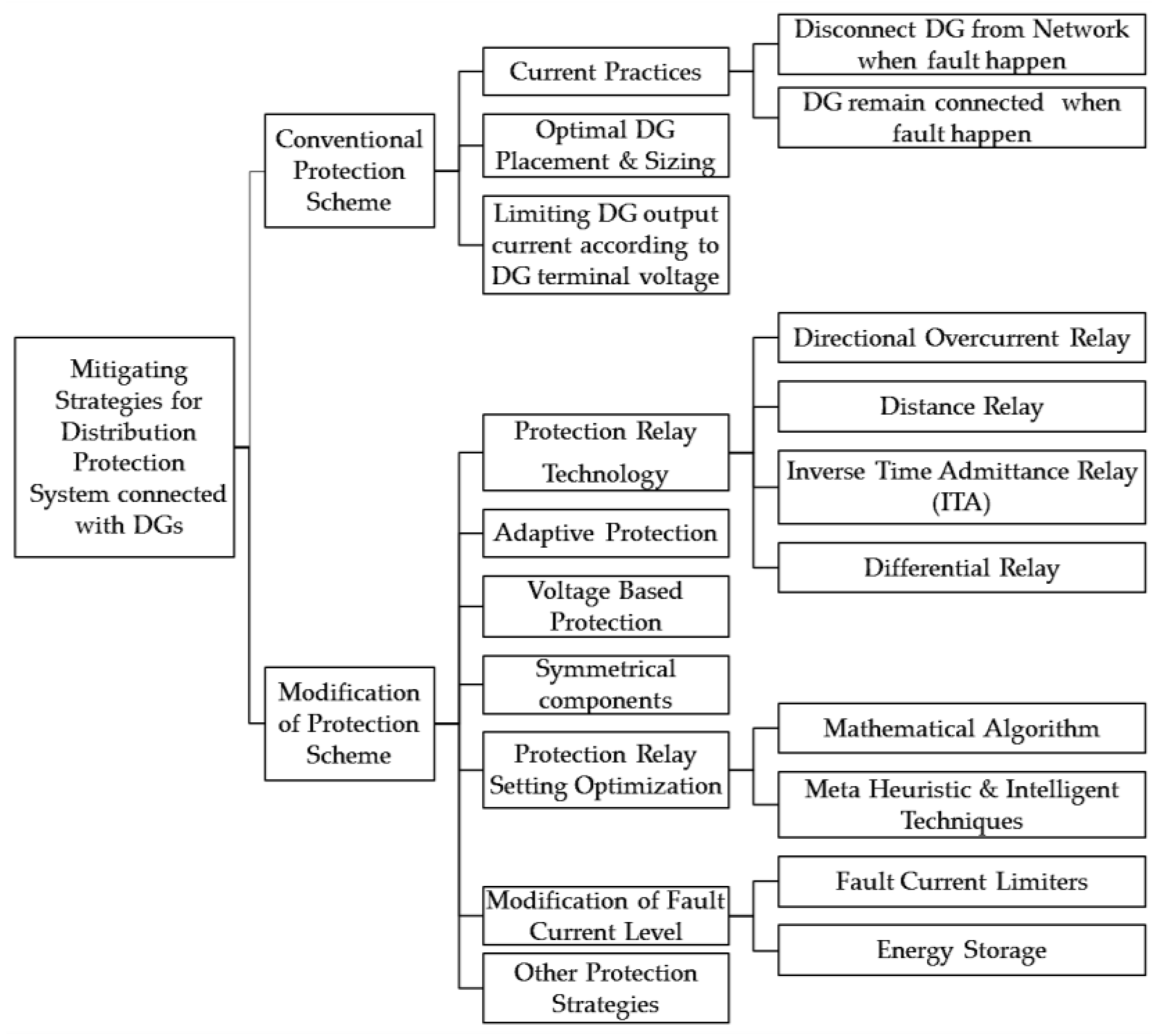
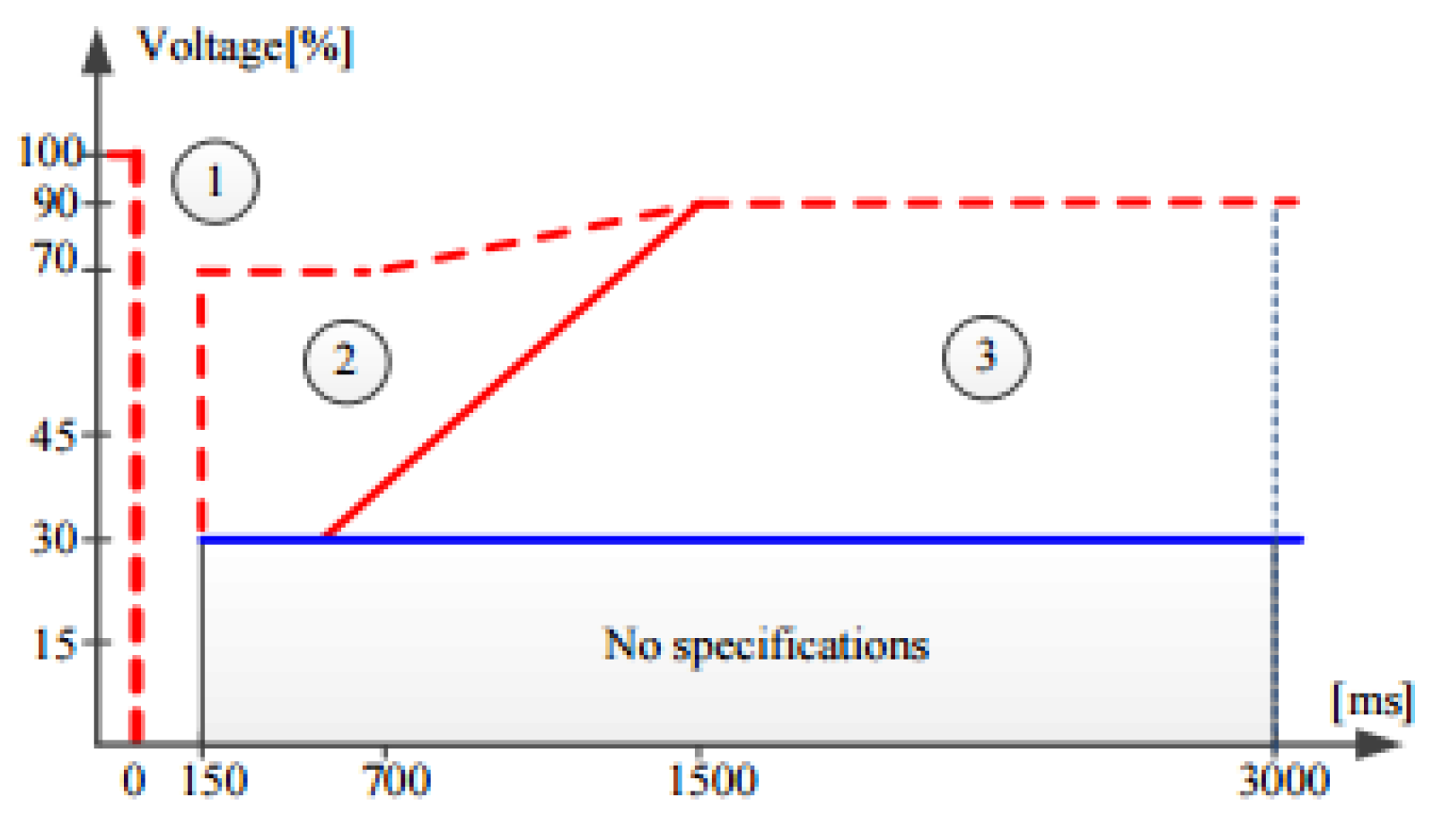

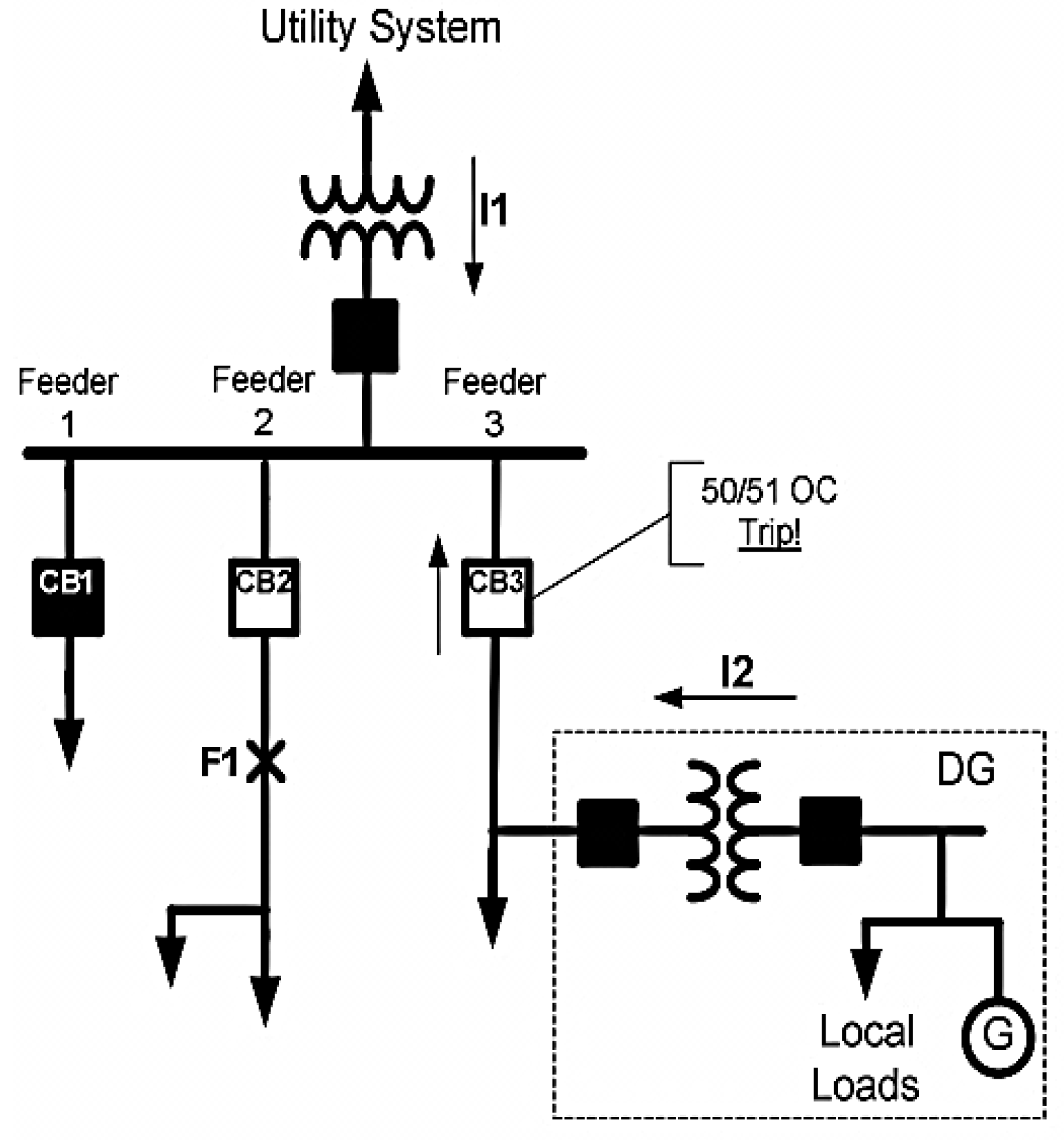
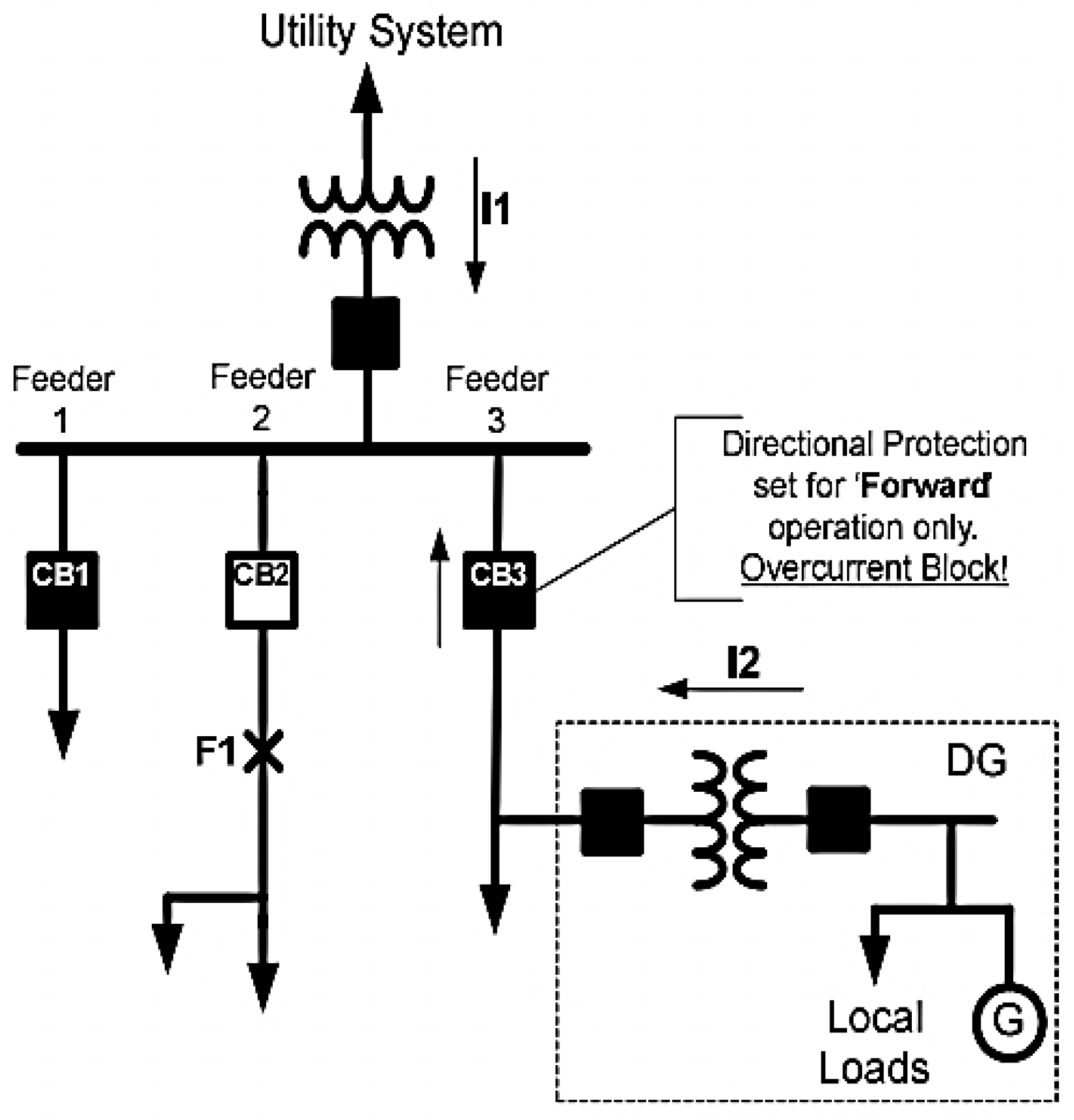

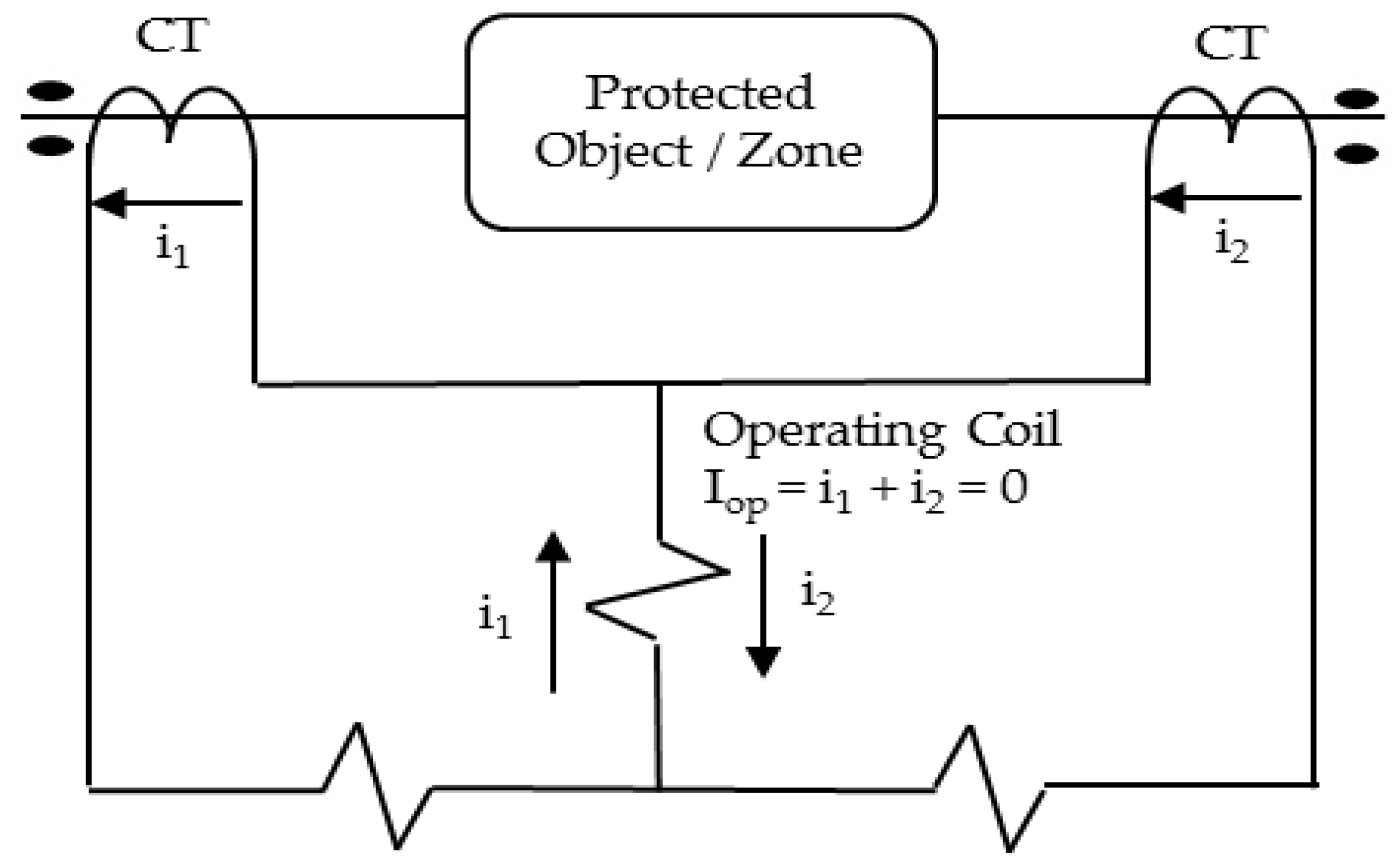
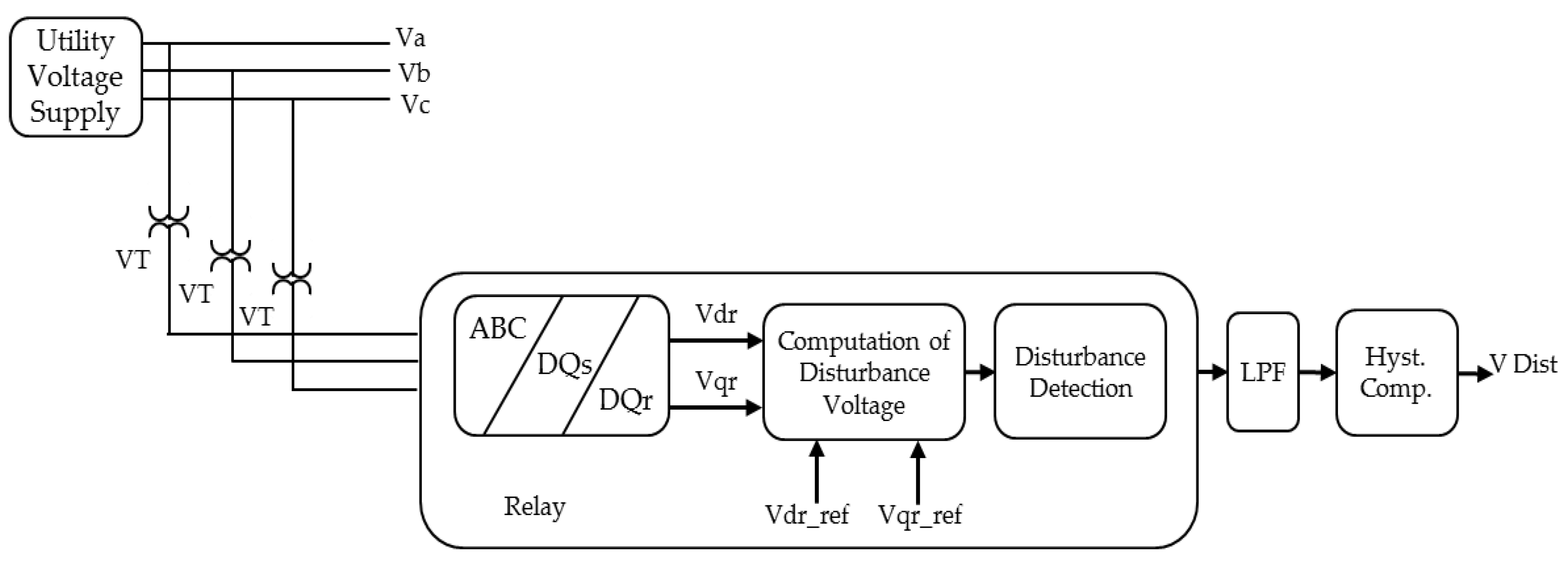
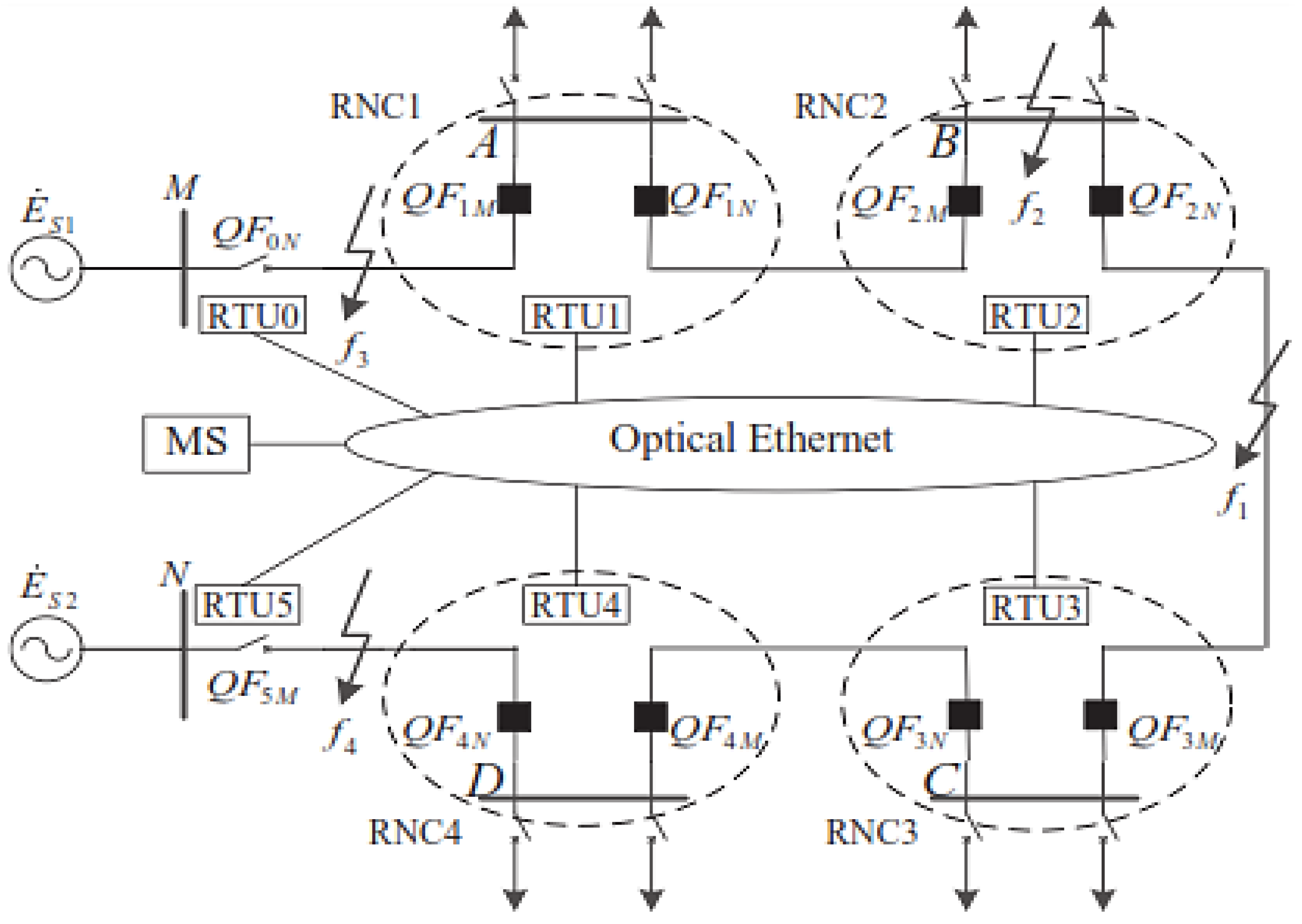
| Protection Strategy | Advantages | Disadvantages | Protection Device | Need for Communication Links | Cost |
|---|---|---|---|---|---|
|
|
| Over Current Relay | No | Reasonable |
|
|
| Over Current Relay | No | Expensive |
|
|
| Over Current Relay | No | Reasonable |
|
|
| Fuse-recloser coordination | No | Reasonable |
| Country | Fault-Ride-Through Capability | ||
|---|---|---|---|
| Fault Duration (ms) | Voltage Drop Level (Urated) | Post Fault Time Recovery (s) | |
| Canada (Hydro-Quebec) | 150 | 0% | 0.18 |
| Denmark | 50 | 20% | 1 |
| Egypt | 250 | 0% | 10 |
| Germany | 150 | 0% | 3 |
| Ireland | 600 | 50% | - |
| Malaysia | 150 | 0% | 5 |
| Spain | 500 | 20% | 0.5 |
| UK | 140 | 15% | 1.2 |
| Zone | Behavior During Fault | Remarks |
|---|---|---|
| 1 | DG must remain connected | The PVDG must not disconnect although fault happen at 0V within a duration of 150 ms. |
| 2 | DG may disconnect | The PVDG is permitted to disengage from DN depending on contract. |
| 3 | DG must disconnect | Protection relays to disengage the PVPP from DN. |
| Protection Strategy | Advantages | Disadvantages | Protection Device | Need for Communication Links | Cost |
|---|---|---|---|---|---|
| |||||
|
|
| Directional Over Current Relay | No | Expensive |
|
|
| Distance Relay | Yes | Reasonable |
|
|
| Inverse Time Admittance Relay | No | Expensive |
|
|
| Digital relay | Yes | Very expensive |
|
|
| Voltage restrained over current relay/Numerical DOCR | Yes | Expensive |
|
|
| Over current relay or FCL | No | FCL is reasonable Energy storage is very expensive |
|
|
| Voltage monitoring relay | Yes | Expensive |
|
|
| Digital distance relay | Yes | Expensive |
|
|
| Depends on optimization technique | No | Reasonable |
© 2017 by the authors. Licensee MDPI, Basel, Switzerland. This article is an open access article distributed under the terms and conditions of the Creative Commons Attribution (CC BY) license (http://creativecommons.org/licenses/by/4.0/).
Share and Cite
Norshahrani, M.; Mokhlis, H.; Abu Bakar, A.H.; Jamian, J.J.; Sukumar, S. Progress on Protection Strategies to Mitigate the Impact of Renewable Distributed Generation on Distribution Systems. Energies 2017, 10, 1864. https://doi.org/10.3390/en10111864
Norshahrani M, Mokhlis H, Abu Bakar AH, Jamian JJ, Sukumar S. Progress on Protection Strategies to Mitigate the Impact of Renewable Distributed Generation on Distribution Systems. Energies. 2017; 10(11):1864. https://doi.org/10.3390/en10111864
Chicago/Turabian StyleNorshahrani, Mohamad, Hazlie Mokhlis, Ab. Halim Abu Bakar, Jasrul Jamani Jamian, and Shivashankar Sukumar. 2017. "Progress on Protection Strategies to Mitigate the Impact of Renewable Distributed Generation on Distribution Systems" Energies 10, no. 11: 1864. https://doi.org/10.3390/en10111864





